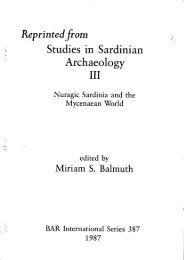The Island of Capri in the Gulf of - Claudio Giardino
The Island of Capri in the Gulf of - Claudio Giardino
The Island of Capri in the Gulf of - Claudio Giardino
You also want an ePaper? Increase the reach of your titles
YUMPU automatically turns print PDFs into web optimized ePapers that Google loves.
PepBns rN IrernN AncHasolocv VI<br />
Ols<br />
Iro<br />
T<br />
27<br />
Irs<br />
I.v<br />
0 0s<br />
tÉ..ffi{ t<br />
km<br />
Mar<strong>in</strong>a Crande<br />
Mar<strong>in</strong>a Piccola<br />
D<br />
I Neoüthlc<br />
O CopperAge<br />
I Bronze Age<br />
* Inon Age<br />
* PreProtohlstory<br />
Fig. 2. I. <strong>Capri</strong>-Hotel Quisisana; 2. Petrara (o Munaciello); 3. Grotta di S. Michele; 4. Le Parate; 5. Mongìard<strong>in</strong>o; 6.<br />
Il Capo ('Sopra Tiberio'); 7. Grotta di Matermania; 8. Tragara; 9. Grotta delle Felci; 10. Riparo Kromberger; ll.<br />
Cave under Monte Solaro; 12. S. Maria a Cetrella; 13. La Tor<strong>in</strong>a; 14. L'Ang<strong>in</strong>ola; 15. Calcara; 16. Mar<strong>in</strong>a Grande-9.<br />
Costanzo; 17. Hotel Cesare Augusto; 18. Damecuta; 19. Punta Capocchia; 20. Rio; 21. Campetiello; 22. Mesola (or<br />
Messolo); 23. Grotta del Pisco; 24. P<strong>in</strong>o; 25. Il Limmo; 26. 'Between Torre della Guardia and Belvedere Migliara';<br />
27. Via Aiano di Sopra.<br />
<strong>The</strong> cave is a small natural cavity: it is about twenty<br />
meters long and approximately eighteen meters wide; it is<br />
one hundred meters high on <strong>the</strong> sea level. <strong>The</strong> access is<br />
from <strong>the</strong> northo after <strong>the</strong> larger Grotta dell'Arco; with<br />
some difficulty it is possible to get from <strong>the</strong> sou<strong>the</strong>rn side<br />
to <strong>the</strong> sea below.<br />
A large rock fixed to <strong>the</strong> ground closes <strong>the</strong> western side<br />
<strong>of</strong> <strong>the</strong> cave. <strong>The</strong> vault is a dozen meters from <strong>the</strong> acfual<br />
floor and it is covered by degraded stalactites. Neolithic<br />
burials were found <strong>in</strong> <strong>the</strong> hollows <strong>of</strong> <strong>the</strong> northwestern<br />
wall <strong>of</strong> <strong>the</strong> cavern; <strong>in</strong> <strong>the</strong>se burials rich objects were<br />
placed with <strong>the</strong> deceased. Already from this early day, <strong>the</strong><br />
Grotta delle Felci had an evident ritual function. This<br />
peculiar aspect is emphasized also by <strong>the</strong> recovery <strong>of</strong><br />
amulets <strong>in</strong> stone, toge<strong>the</strong>r with very reÍìned pa<strong>in</strong>ted<br />
pottery.<br />
<strong>The</strong> cave held its sacral role all over <strong>the</strong> prehistory. It was<br />
<strong>the</strong> sanctuary <strong>in</strong> which <strong>the</strong> community <strong>of</strong>ficiated its own<br />
cults, executed its sacrifices and, <strong>in</strong> <strong>the</strong> Neolithic, buried<br />
his deads. <strong>The</strong> ceremonies carried out <strong>in</strong> <strong>the</strong> cave had<br />
complex rituals: vessels fulI <strong>of</strong> foods and dr<strong>in</strong>ks were<br />
<strong>of</strong>fered to <strong>the</strong> div<strong>in</strong>ity <strong>in</strong> úis place.<br />
Some records made dur<strong>in</strong>g <strong>the</strong> digg<strong>in</strong>g testiff <strong>the</strong><br />
existence <strong>of</strong> elaborated ritual practises. Two jars were<br />
found upside down <strong>in</strong>side <strong>the</strong> funerary hollows. Red<br />
ochre had an important role <strong>in</strong> this prehistoric religion.<br />
Gr<strong>in</strong>ders and pestles were found on <strong>the</strong> floor levels; <strong>the</strong>y<br />
were used to reduce <strong>the</strong> ochre to powder. Ochre powder<br />
626<br />
was found on <strong>the</strong> ground <strong>of</strong> <strong>the</strong> cave, <strong>in</strong>tentionally<br />
scattered to produce a wide spot, toge<strong>the</strong>r with a<br />
reddened pestle. Dur<strong>in</strong>g <strong>the</strong> excavation a pot was found<br />
still conta<strong>in</strong><strong>in</strong>g some ochre. Schematic, symbolic pictures<br />
were pa<strong>in</strong>ted with ochre on some pebbles (Fig. 4:2).<br />
Those pebbles are probably attributable to <strong>the</strong> Neolithic<br />
levels; <strong>the</strong>y are most likely some k<strong>in</strong>d <strong>of</strong> idol or fetish.<br />
<strong>The</strong> çave was dug <strong>in</strong> several campaigns <strong>of</strong> excavations.<br />
<strong>The</strong> first digg<strong>in</strong>g was carried out by lgnazio Cerio, at <strong>the</strong><br />
end <strong>of</strong> <strong>the</strong> 19th century; Ugo Rell<strong>in</strong>i led o<strong>the</strong>r excavations<br />
<strong>in</strong> 192l-1922. Alberto Carlo Blanc made ano<strong>the</strong>r digg<strong>in</strong>g<br />
<strong>in</strong> 1941; it was ma<strong>in</strong>ly <strong>of</strong> palaeontological <strong>in</strong>terest. Cerio<br />
dug <strong>the</strong> most superficial levels, with <strong>the</strong> Bronze Age<br />
layers. He found a stratigraphic sequence a pair <strong>of</strong> meters<br />
depth; <strong>the</strong> deposit had however to be orig<strong>in</strong>ally higher.<br />
As Cerio briefly reports, <strong>the</strong> superficial layer conta<strong>in</strong>ed<br />
modern, roman and protohistoric materials; this is a clear<br />
<strong>in</strong>dication <strong>of</strong> <strong>the</strong> un<strong>in</strong>temrpted frequentation <strong>of</strong> <strong>the</strong> site;<br />
<strong>the</strong> Bronze Age levels (1700-1000 BC) were just under<br />
<strong>the</strong> soil.<br />
'Natural' soil: <strong>the</strong> disturbed superficial layer,<br />
conta<strong>in</strong>ed modern and roman potsherds toge<strong>the</strong>r with<br />
several Bronze Age fragments;<br />
Level l: it was an <strong>in</strong>tact layer, <strong>in</strong> which traces <strong>of</strong><br />
hearths were recovered toge<strong>the</strong>r with bones, shells<br />
and Bronze Age potsherds;<br />
Level 2: it was a small sterile layer, consolidated by<br />
<strong>the</strong> ancient walk<strong>in</strong>g, constituted by f<strong>in</strong>e limestone silt<br />
formed because <strong>of</strong> <strong>the</strong> break<strong>in</strong>g up <strong>of</strong> <strong>the</strong> vault dur<strong>in</strong>g



